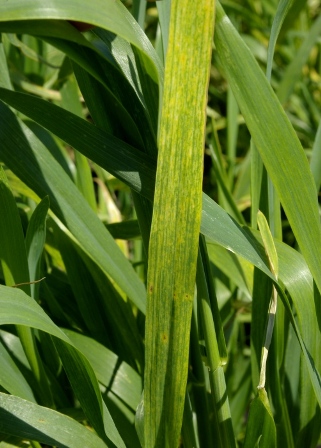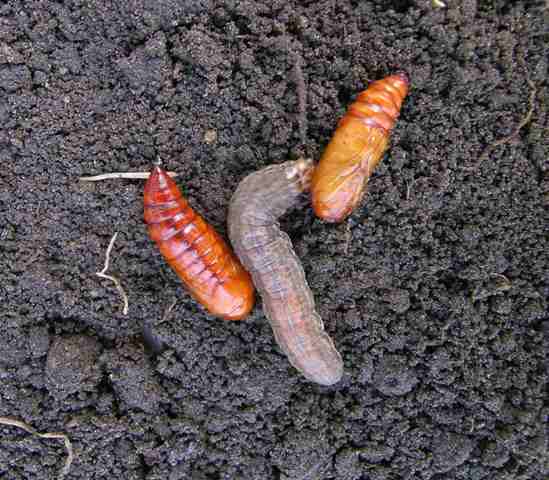Manitoba Insect & Disease Update: June 9, 2015
Summary
Flea beetles in canola and cutworms continue to be the insects of greatest concern. Insecticide applications and some reseeding have occurred because of feeding by these insects.
Monitor emerging crops for seedling disease. So far populations of disease vectors have been low. Aphid vectors of barley yellow dwarf have not been seen or reported, and only small populations of aster leafhopper have been reported so far; these should not be of concern in field crops.
Canola
Flea beetles continue to be a concern in many areas of Manitoba, with foliar insecticide applications being needed in many regions. Canola plants will become less vulnerable once 3 or 4 true leaves have emerged.
The flea beetle that are present in canola fields currently are the same flea beetles that were present late last summer and overwintered. These are starting to die off and by late June populations of adult flea beetles get quite low.
No new adult flea beetles are being added to the population in the spring and early summer, these are only those surviving through the winter. New flea beetles produced this year will start showing up in late summer.
Cereal Crops
Wheat Streak Mosaic: A winter wheat sample from the Eastman region has tested positive for Wheat Streak Mosaic. This disease is caused by a virus and vectored by the wheat curl mite. The disease and mite overwinter on winter wheat and the mites are easily moved from field to field with the wind. Field edges, especially in spring wheat fields near winter wheat fields, should be scouted for the presence of this disease. Common symptoms include chlorotic stripes on the leaves running parallel to the veins (see Fig. 1). Plants may also appear stunted and the leaf edges may curl upward and inward.

Figure 1. Wheat streak mosaic
Fusarium Head Blight: Winter wheat across the province is nearing the flowering stage where a fungicide application for Fusarium Head Blight may be warranted. The provincial Fusarium Head Blight risk maps will be published on the MAFRD website starting mid-June. These maps provide broad information on current risk of FHB infection; individual fields should be scouted as local conditions will vary.
Insects and Pathogens in Multiple Crops
Cutworms: Cutworms continue to be of concern, with insecticide applications for cutworms being reported over the past week in sunflowers, soybeans, and dry beans.
The stage of growth the larvae are in will depend on the species and temperatures the larvae have been exposed to, with quicker development under warmer temperatures. In some fields cutworms may remain in the larval stages for another week or two before starting to turn to pupae, after which their damaging stage will be complete. The stage of cutworms can vary between fields. Larvae of redbacked cutworms, which seems to be one of our common species this year, get to be about 38 cm long (about 1.5 inches) when fully grown. After this they will turn to pupae (Figure 2). So in addition to the amount of cutworms and amount of feeding occurring to the crop, this time of year it is good to consider the size of the cutworms in decision making. If most are quite large their feeding will be ending soon. Also consider whether populations in a field are patchy, as is often the case.

Figure 2. Pupae and larva (centre) of redbacked cutworm.
Threshold for cutworms in soybeans and dry beans: One of the common questions this week was is there an economic threshold for cutworms in soybeans. The short answer is no. No studies have been done to produce a proper economic threshold for cutworms in soybeans. There are however, nominal thresholds that can be used as guidelines. Nominal thresholds are based on experience and the best available information, rather than research quantifying the impact of the insect on the crop.
Nominal threshold that may be used for cutworms in soybeans and dry beans are 1 or more larvae per three feet of row and larvae are small (less than 2 cm), or 20% of plants cut.
Soybeans are a crop that is quite good at compensating for defoliation. So it is good to note how much clipping of plants is occurring. Different species of cutworms may result in different levels of stem clipping.
Insect Monitoring Programs
Diamondback Moth: The following are the highest cumulative counts for the traps for adult diamondback moth in Manitoba from April 26 to June 9, 2015.
| Nearest Town | GO Team | Cumulative Trap Count |
|---|---|---|
| Portage la Prairie | Central Plains | 148 |
| Morris | Red River | 135 |
| The Pas | Valleys North | 119 |
| Swan River | Valleys North | 91 |
| Kane | Red River | 79 |
| Faulkner | North Interlake | 68 |
| The Pas | Valleys North | 67 |
| Gilbert Lake | North Parkland | 58 |
| Durban | Valleys North | 56 |
Numbers overall are not very high, but it appears some moths have arrived. How economical this is likely to become is hard to say and depends on many factors, including weather and natural enemies that may either overwinter in Manitoba or potentially move in on the same winds as diamondback moth. Look for signs of feeding and larvae of diamondback moth during regular field scouting. So far there have been no reports of larvae of diamondback moth being found.
Bertha armyworm: A reminder for those involved in the monitoring program for adults of bertha armyworm that traps can now be set up.
Tick Talk
This time of year it is quite common to get wood ticks (also known as American dog ticks) while walking through areas with tall vegetation. Much less common is the blacklegged tick (also known as deer tick), which do have the potential to vector Lyme disease. Many may become concerned when they get a tick about the risk of disease vectoring. The first step is in identification. The factsheet at the link below may be helpful in determining if the tick is a wood tick or blacklegged tick. In regards to Lyme disease, wood ticks are not considered a public health concern. Note that unlike the wood tick, blacklegged ticks do not have white markings on their body.
The following video by Dr. Kateryn Rochon of the University of Manitoba, shows an effective method to remove a tick: https://www.youtube.com/watch?v=27McsguL2Og&feature=youtu.be

Figure 3. Wood tick.
Compiled by:
•John Gavloski, Entomologist
Manitoba Agriculture, Food and Rural Development
Phone: (204) 745-5668
Fax: (204) 745-5690.
•Holly Derksen, Plant Pathologist
Manitoba Agriculture, Food and Rural Development
Phone: (204) 745-4248
Fax: (204) 745-5690
To report observations on insects or plant pathogens that may be of interest or importance to farmers and agronomists in Manitoba, please send messages to the above contact address.
To be placed on an E-mail list so you will be notified immediately when new Manitoba Insect and Disease Updates are posted, please contact John Gavloski at the address or numbers listed above.
Manitoba Insect & Disease Update: June 2, 2015
